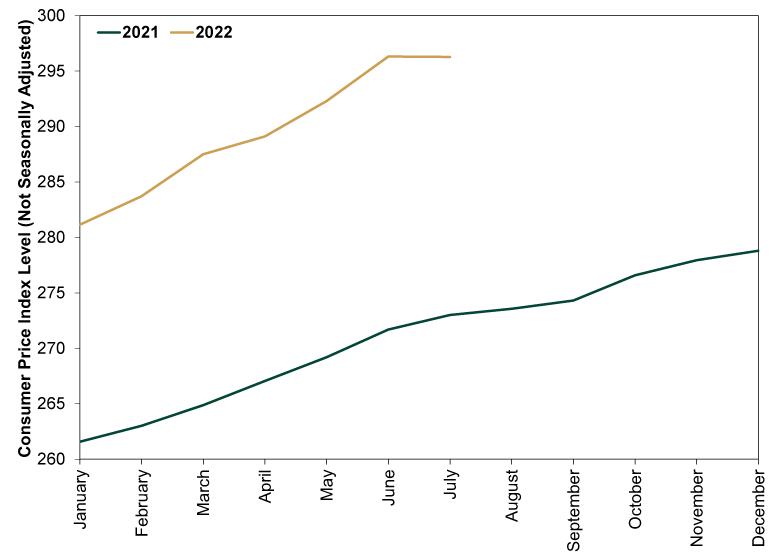Personal Wealth Management / Market Analysis
An Overlooked Reason Behind July’s Slowing Inflation
The base effect kicks in.
Editors’ Note: Inflation remains a hot political topic, so please understand that our commentary is intentionally non-partisan and focused on the potential market implications only.
In all the coverage of July’s inflation report, we have seen numerous explanations for why the inflation rate decelerated from June’s 9.1% y/y to 8.5% y/y. There is much chatter about falling gasoline prices. Some argue the Fed’s recent moves are starting to bear fruit. We see an alternative, widely overlooked explanation, and we think understanding it can help investors better navigate inflation’s wiggles over the period ahead.
That explanation: the base effect, which we have long eyed as a likely disinflationary force this year. The inflation rate, as a year-over-year calculation, measures the percentage change between prices in one month and that same month a year prior. The “base” is that year-ago price level, which is the denominator in the calculation. As we all learned in grade school fraction lessons, a higher denominator can result in a smaller quotient—and vice versa. That is what happened in July.
On a month-over-month basis, headline CPI was flat (an encouraging development that we will get to momentarily). But prices in July 2021 rose 0.5% from June 2021. That gives us a constant numerator divided by a larger denominator. Presto, lower inflation rate.
We aren’t pointing this out to talk down the deceleration, which seems to be giving investors some relief. Nor do we mean anything political by going here. Rather, we think there is a good chance that the base effect continues having a balancing effect from here. To see the potential, consider Exhibit 1. It shows the CPI level in 2022 (the numerators) and 2021 (the denominators). As you will see, prices’ autumn 2021 rise will raise the calculation base over the rest of this year. Then, as we head into 2023, early 2022’s sharp rises will move into the denominator, adding more disinflationary math.
Exhibit 1: The CPI Base Effect, Deconstructed

Source: St. Louis Fed, as of 8/10/2022.
Hence, even if month-over-month price changes don’t remain at zero from here, the inflation rate could still moderate. We saw this, to an extent, in “core” inflation, which excludes food and energy prices, in July. On a month-over-month basis, core prices rose 0.3%, matching the long-term average.[i] But the year-over-year core inflation rate stayed at 5.9%, matching June’s reading.[ii] The rising denominator simply canceled out the numerator’s wiggle.
This is encouraging, in our view, because it would be unrealistic to expect month-over-month price moves to stay at zero from here, much less dip negative for a long stretch. After all, it isn’t like prices stabilized across the board in July. That flat month-over-month headline rate stems from a bunch of goods and services’ offsetting energy prices’ -4.6% m/m fall.[iii] We would love it if that fall repeated from here, but that category is notoriously bouncy, which is a big reason the core measure exists. Beyond that, the most likely scenario to us has always been that after the US economy swallowed this year’s big price moves—once energy costs, shortages and shipping bottlenecks worked their way through the system—prices would probably grow more slowly off a higher base. We think July is a real-time example of what this would look like.
Not that the inflation rate has peaked, mind you. Inflection points are only clear with a good amount of hindsight. Food prices are still pretty jumpy, and there may still be some consumer products with petrochemical feedstock where higher oil prices haven’t quite filtered through due to companies’ use of futures contracts to lock in prices. So there may still be a few bumps ahead. Some services businesses may still need to work through staffing shortages, overhead cost increases and other factors that have forced price rises in recent months. Airfares, which mercifully fell in July, may have more wiggles ahead as the world continues inching back to pre-pandemic travel norms.
But July’s results show that even with volatility from month to month, the base effect can still stabilize the headline rate enough to help sentiment improve. That is primarily what matters from an investing standpoint, in our view. Inflation was one of the biggest factors weighing on sentiment during this year’s bear market. From a fundamental standpoint, we think businesses and the economy are equipped to stomach higher prices, considering consumer spending has continued growing on an inflation-adjusted basis this year. But sentiment and reality often veer, creating room for inflation improvement to be a tonic even if it doesn’t represent much for the economy at a fundamental level.
If you would like to contact the editors responsible for this article, please message MarketMinder directly.
*The content contained in this article represents only the opinions and viewpoints of the Fisher Investments editorial staff.
Get a weekly roundup of our market insights
Sign up for our weekly e-mail newsletter.

You Imagine Your Future. We Help You Get There.
Are you ready to start your journey to a better financial future?

Where Might the Market Go Next?
Confidently tackle the market’s ups and downs with independent research and analysis that tells you where we think stocks are headed—and why.





